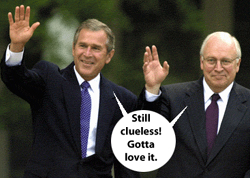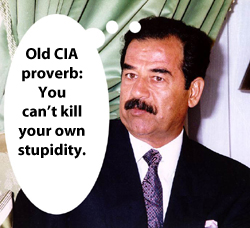Don’t know how they managed it, but the Bush administration appears to have found a way to evoke sympathy for one of the biggest mass murderers in modern Middle East history (in the same league as Bush himself, in fact). The ugly spectacle of Saddam’s hanging was somewhat reminiscent of the Abu Ghraib images — dim, shabby, shameful. As regular readers of  this sorry blog know, I am no fan of the death penalty, even when it comes to war criminals like Saddam and, well, George Bush. This goes beyond the question of basic humanity, though. If you’re going to execute someone, that should be punishment enough without making a circus of it. As it was, they (i.e. the American idiots who decided on this policy) made Hussein seem dignified by comparison and, in so doing, further inflamed the Sunni community in Iraq and throughout the Middle East by allowing the deed to be performed on the day Sunnis celebrate Eid. I can’t entirely blame the Shi’a execution squad for behaving as they did — that’s to be expected. But don’t tell me no one in the Green Zone knew that particular detail wouldn’t be shot through with militia people.
this sorry blog know, I am no fan of the death penalty, even when it comes to war criminals like Saddam and, well, George Bush. This goes beyond the question of basic humanity, though. If you’re going to execute someone, that should be punishment enough without making a circus of it. As it was, they (i.e. the American idiots who decided on this policy) made Hussein seem dignified by comparison and, in so doing, further inflamed the Sunni community in Iraq and throughout the Middle East by allowing the deed to be performed on the day Sunnis celebrate Eid. I can’t entirely blame the Shi’a execution squad for behaving as they did — that’s to be expected. But don’t tell me no one in the Green Zone knew that particular detail wouldn’t be shot through with militia people.
There’s an even more critical issue here. The execution of Saddam Hussein closes off a rich source of critical testimony regarding crimes committed during his rule and the accountability of those associated with him during those years. That includes whatever light he could shed on American and European complicity in the war against Iran, the use of chemical weapons against Persians, Shi’a Arabs, and Kurds, and so on. As Richard Falk pointed out on Democracy Now!, Hussein was put to death for an act of collective punishment that had nothing to do with the U.S. If he had been prosecuted for his serial chemical attacks from 1983 forward, we might have learned more about our role in facilitating those attacks, apologizing for them, covering them up, etc. Not that any of those details would make it into the mainstream American press, which has essentially expunged the U.S. role in supporting Hussein from their various retrospectives and timelines.
 Such are the fortunes of those who benefit from U.S. covert operations — some retire to Florida (Orlando Bosch); others dangle from the end of a rope. The CIA apparently fostered Saddam’s early career as a torturer and assassin, quietly supporting his participation in 1959 in a notorious attempt on the life of the Iraqi president (who was a communist). After he became Iraq’s leader (something like Lee Harvey Oswald becoming president), he received crucial support from the U.S., particularly during the Reagan / Bush I administrations, who unfailingly portrayed him as a “moderating influence” in Middle Eastern affairs right up until his invasion of Kuwait. While they turned against Saddam at that point, it was in such a way as to allow him to carry out one of the greatest atrocities of his career — putting down the Kurdish and Shi’a uprisings George Bush Sr. had actively encouraged, as the army of “Stormin’ Norman” Schwartzkopf looked on just a few miles away. Aside from resulting in probably half a million deaths, the Clinton era sanctions only strengthened Saddam’s grip on his nation, forcing ordinary Iraqis to rely on the central government for subsistence. Now, of course, we are busily compounding the heinous errors of past administrations with even more heinous errors, including a Bush surge strategy that will focus on targeting the denizens of Baghdad’s poorest neighborhoods and the most vulnerable portions of Iraq’s majority Shi’a community.
Such are the fortunes of those who benefit from U.S. covert operations — some retire to Florida (Orlando Bosch); others dangle from the end of a rope. The CIA apparently fostered Saddam’s early career as a torturer and assassin, quietly supporting his participation in 1959 in a notorious attempt on the life of the Iraqi president (who was a communist). After he became Iraq’s leader (something like Lee Harvey Oswald becoming president), he received crucial support from the U.S., particularly during the Reagan / Bush I administrations, who unfailingly portrayed him as a “moderating influence” in Middle Eastern affairs right up until his invasion of Kuwait. While they turned against Saddam at that point, it was in such a way as to allow him to carry out one of the greatest atrocities of his career — putting down the Kurdish and Shi’a uprisings George Bush Sr. had actively encouraged, as the army of “Stormin’ Norman” Schwartzkopf looked on just a few miles away. Aside from resulting in probably half a million deaths, the Clinton era sanctions only strengthened Saddam’s grip on his nation, forcing ordinary Iraqis to rely on the central government for subsistence. Now, of course, we are busily compounding the heinous errors of past administrations with even more heinous errors, including a Bush surge strategy that will focus on targeting the denizens of Baghdad’s poorest neighborhoods and the most vulnerable portions of Iraq’s majority Shi’a community.
If nothing else, we are demonstrating that you can kill hope if you try hard enough… but stupidity is a lot more resilient.
luv u,
jp
